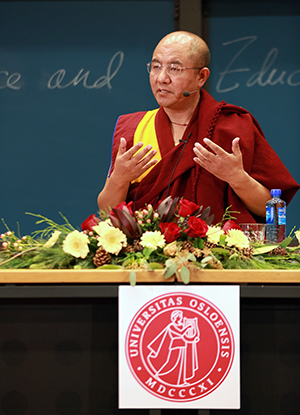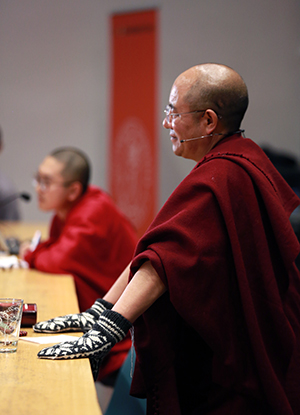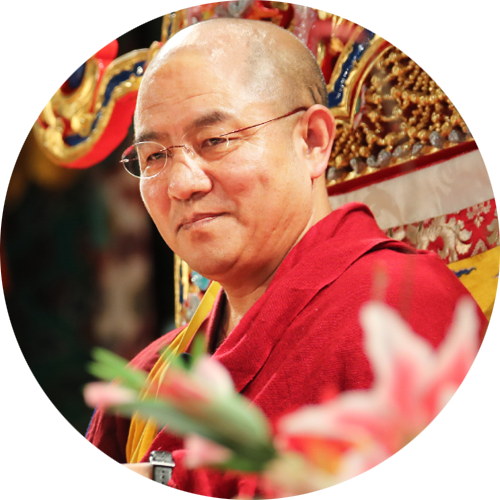Religious Practice and Education in Tibetan Buddhism
Tibetan Buddhism is actually a rational education system which focuses on study, reflection and practice of the Dharma teachings. Firstly, we need receive transmission from qualified teachers, and there are six different ways of transmission. Secondly, through learning and reflecting on the Five Great Treatises, we can gain insight on the truth. Thirdly, in terms of practice, the cultivation of bodhichitta is the most fundamental in Tibetan Buddhism.
The Most Fundamental Practice of Tibetan Buddhism
Excerpt 1: Systematic Education of Tibetan Buddhism
Tibetan Buddhism emphasizes hearing, contemplation and meditation. We should first listen to the teachings from a teacher, and then contemplate on them, and finally put them into practice. Actually, this process can be applied to all forms of education. When studying the Dharma, we should find a qualified teacher and learn from him. There are different criteria for one to be a qualified teacher in Theravada, Mahayana and Vajrayana tradition respectively. Without proper listening and studying of the Dharma, it is impossible to become a real Buddhist practitioner. We all know that without instructions from the teachers, we cannot master the essence of any subjects, no matter how clever we are or how many books we have read.
Excerpt 2: The Wisdom Coming from Reflection
Next, I would like to talk about the reflection. Tibetan Buddhism emphasizes wisdom of contemplation. This means that after listening to what the teacher has taught, we should reflect on the teachings by various means such as debates, discussions and comparative studies. Through these methods we will gain deeper understanding and wisdom. Actually, contemplative wisdom is also highly valued in many modern colleges and universities. For example, the activities to stimulate the development of intelligence, such as exams or debates, are very popular in many courses all over the world, in both the Western and the Eastern countries. I think it’s very important to clear all our doubts through careful analysis of every issue.
Excerpt 3: The Most Fundamental Practice of Tibetan Buddhism
Thirdly, I would like to give a very brief introduction to spiritual practice in Tibetan Buddhism. There are many methods of practice in the Sutrayana and the Tantrayana. Of all these practices, the most fundamental is to cultivate compassion and bodhichitta. Actually, bodhichitta is a rather high level of realization, which is an aspiration to lead all sentient beings to ultimate enlightenment.
Excerpt 4: Spiritual Practice Is Conducive to Psychological Well-being
In every country, there are growing number of people who are suffering from various mental afflictions especially depression. What are the causes of these problems despite all the technological progress? The root of these problems is probably we focus and rely on external objects while neglecting our inner mind. If we often engage in actual practice of meditation, compassion and all sorts of other spiritual practices, our inner mind can be very pure and peaceful. Though not every one of us can do a great deed, if we do things with great love and compassion, we can always bring happiness to people around us.
Excerpt 5: May the Light of Love Illuminate the Entire World
Whenever I see candles, I would make a wish, “May I become a small candle, with the light of love, dispel the darkness of my own and people around me. May everyone gather together as sources of light to illuminate the entire world!”

The Most Fundamental Practice of Tibetan Buddhism
There are many methods of practice in the Sutrayana and the Tantrayana. Of all these practices, the most fundamental is to cultivate compassion and bodhichitta. Actually, bodhichitta is a rather high level of realization, which is an aspiration to lead all sentient beings to ultimate enlightenment.

May the Light of Love Illuminate the Entire World
Whenever I see candles, I would make a wish, “May I become a small candle, with the light of love, dispel the darkness of my own and people around me. May everyone gather together as sources of light to illuminate the entire world!”
“An important aspect of Tibetan Buddhism is that the tradition is taught systematically like any other education system. Thus all Tibetan monasteries’ curriculum comprises Buddhism as core subject and other related subjects.”
